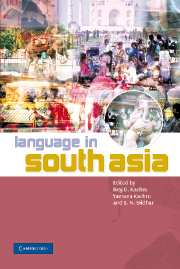Book contents
- Frontmatter
- Contents
- List of Figures
- List of Maps
- List of Tables
- Preface
- Acknowledgments
- List of Abbreviations
- Note on Transcription
- Introduction: languages, contexts, and constructs
- Part 1 Language history, families, and typology
- Part 2 Languages and their functions
- 3 Hindi–Urdu–Hindustani
- 4 Persian in South Asia
- 5 Major regional languages
- 6 Minority languages and their status
- 7 Tribal languages
- Part 3 Sanskrit and traditions of language study
- Part 4 Multilingualism, contact, and convergence
- Part 5 Orality, literacy, and writing systems
- Part 6 Language conflicts
- Part 7 Language and modernization
- Part 8 Language and discourse
- Part 9 Language and identity
- Part 10 Languages in diaspora
- References
- Subject Index
- Language Index
- Author Index
5 - Major regional languages
Published online by Cambridge University Press: 04 May 2010
- Frontmatter
- Contents
- List of Figures
- List of Maps
- List of Tables
- Preface
- Acknowledgments
- List of Abbreviations
- Note on Transcription
- Introduction: languages, contexts, and constructs
- Part 1 Language history, families, and typology
- Part 2 Languages and their functions
- 3 Hindi–Urdu–Hindustani
- 4 Persian in South Asia
- 5 Major regional languages
- 6 Minority languages and their status
- 7 Tribal languages
- Part 3 Sanskrit and traditions of language study
- Part 4 Multilingualism, contact, and convergence
- Part 5 Orality, literacy, and writing systems
- Part 6 Language conflicts
- Part 7 Language and modernization
- Part 8 Language and discourse
- Part 9 Language and identity
- Part 10 Languages in diaspora
- References
- Subject Index
- Language Index
- Author Index
Summary
Introduction
This chapter focuses on various facets of the major regional languages of South Asia (hereafter, SA) with special reference to their role in networking and communication (e.g. media, trade, multiple identities). It shows that the magnitude and scale of regional linguistic diversity and parameters of language use are often beyond the imagination of those who are accustomed to a monolinguistic view of language competence and use, and monolithic linguistic models. Whenever deemed necessary, historical background is provided to clarify the contemporary status and role of regional languages in the communicative and sociopolitical settings of SA. As the home to the largest number of major regional languages in SA, India receives greatest attention, though to give a comparative and contrastive perspective on the topic, Pakistan and Bangladesh are treated in some detail as well. Nepal is home to a great many languages, but little detailed information is available on their sociolinguistic situation. Nepali has gained the status of the national language with more ease in Nepal than Hindi, for example, as the linguistic symbol of the nation in India.
This chapter is divided into two sections: the first section presents a general account of regional languages, and the second section presents a case study of Punjabi and Bengali. The main reason for the selection of these two languages is that while the two languages are regional languages of India, they represent the international dimensions of the regional languages of SA. Punjabi is the dominant language in Pakistan, and Bengali is the national/official language of Bangladesh.
- Type
- Chapter
- Information
- Language in South Asia , pp. 121 - 131Publisher: Cambridge University PressPrint publication year: 2008
- 8
- Cited by

